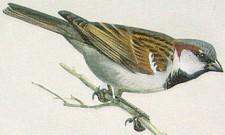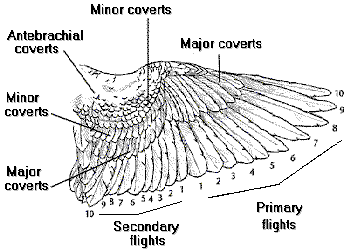 Once
the HOuse SParrow (HOSP) is trapped, its feathers can be trimmed. The best way
to trap it is to use an in-box trap. If the male HOSP (shown) adopts or likes a
box, it becomes very attached to the box, hence it is easy to trap it. HOSP are
very likely to escape when we try to catch them by hand after they are trapped,
hence special methods are needed to remove them from the trapping box.
Both male and female HOSP may be trimmed in this manner.
Once
the HOuse SParrow (HOSP) is trapped, its feathers can be trimmed. The best way
to trap it is to use an in-box trap. If the male HOSP (shown) adopts or likes a
box, it becomes very attached to the box, hence it is easy to trap it. HOSP are
very likely to escape when we try to catch them by hand after they are trapped,
hence special methods are needed to remove them from the trapping box.
Both male and female HOSP may be trimmed in this manner.
 First
get a large clear plastic bag (I use paper shredder bags I buy from "Office
Depot".) Also, have a pair of scissors ready. Put the bag over the box so
the box is all the way into the bag. Put one hand (and arm) inside the bag, the
other hand is used outside the bag to "gather" the bag around your arm
and the mounting pole. Make sure there are no gaps for the HOSP to escape by
holding the bag tightly! Now open the door of the box (all the time keep the bag
closed tightly so no openings can form.) The HOSP will fly right out, fluttering
noisily against the bag. Be careful not to get scared or surprised, keep the bag
closed tight, the bird will not escape. Now catch it with your hand. It may try
to bite you, but besides a little pain it cannot harm you. Once you have it in
your hand, make sure to hold it firmly. Now take it out of the bag, spread one
wing out, carefully count four (on a female) or five (on a male) outermost feathers and trim them near the major
coverts (these are #7,8,9, and 10 on the female and #6,7,8,9, and 10 on the male
in the wing picture shown.) Turn the bird around
and similarly cut the other wing primary feathers. Now let it go. It will fly as
if nothing happened, or it may fly a little lower than usual, either way, the
job is done. [If the trapped bird is not a HOSP, be sure to let it go at once.
In-box traps should be inspected often to make sure no bird is trapped for a
long time. I check mine at least every hour, often I just wait a few minutes and
I see the HOSP getting into the trapping box.]
First
get a large clear plastic bag (I use paper shredder bags I buy from "Office
Depot".) Also, have a pair of scissors ready. Put the bag over the box so
the box is all the way into the bag. Put one hand (and arm) inside the bag, the
other hand is used outside the bag to "gather" the bag around your arm
and the mounting pole. Make sure there are no gaps for the HOSP to escape by
holding the bag tightly! Now open the door of the box (all the time keep the bag
closed tightly so no openings can form.) The HOSP will fly right out, fluttering
noisily against the bag. Be careful not to get scared or surprised, keep the bag
closed tight, the bird will not escape. Now catch it with your hand. It may try
to bite you, but besides a little pain it cannot harm you. Once you have it in
your hand, make sure to hold it firmly. Now take it out of the bag, spread one
wing out, carefully count four (on a female) or five (on a male) outermost feathers and trim them near the major
coverts (these are #7,8,9, and 10 on the female and #6,7,8,9, and 10 on the male
in the wing picture shown.) Turn the bird around
and similarly cut the other wing primary feathers. Now let it go. It will fly as
if nothing happened, or it may fly a little lower than usual, either way, the
job is done. [If the trapped bird is not a HOSP, be sure to let it go at once.
In-box traps should be inspected often to make sure no bird is trapped for a
long time. I check mine at least every hour, often I just wait a few minutes and
I see the HOSP getting into the trapping box.]
HOSP with shortened primary feathers cannot maneuver as well in flying and in
fighting with other birds, so they tend to live peacefully with this handicap.
In six months, they will molt and will get new feathers. Most probably they will
also move away. If not, then the same process is repeated, one year later. With
practice you will be so good at trapping them you will get any of them trapped
in less than 15 minutes...
In years of using various methods, this method works the best for me. Each
year I have raised between 25 and 30 EABL (Eastern Bluebirds) around our house
without killing any HOSP. The HOSP becomes quite friendly, even perches next to
the parent EABL with no fighting. It seems somehow the EABL know the HOSP is
friendly and they do not chase it away! Also,
the HOSP population in our yard is getting reduced as time goes on.
